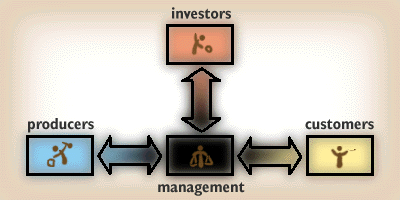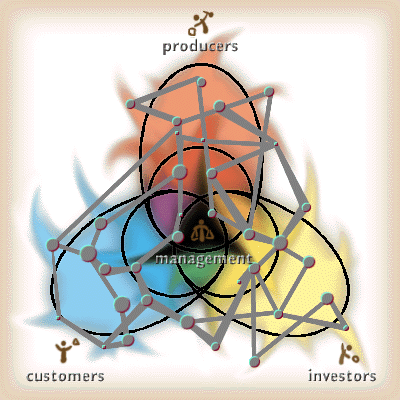MG Taylor Corporation sells ValueWeb Management Services to organizations, generally in conjunction with other elements of our suite of products and services, such as navCENTER sytems. These management services enable enterprises to organize in a unique, non-confrontational structure and manage complex ventures consisting of networks of investors, producers and customers.

As the figure above illustrates, traditionally, the investor provides capital to the enterprise with the hope of receiving a return on the investment, and a return of the original investment as well at some point in time. The producer actually makes the product. Producers are employees, vendors and suppliers that make up the entire chain required to create and deliver a product or service. The customer buys and uses the product. Management provides the information and communication hub between the other players. At different times in history, managers have focused alternately on fulfilling the desires of one player or another.
Management is stuck in the middle, at an intersection of conflicting needs. The investor wants a higher return and a lower risk. The producer wants higher pay or fee for service for less time. The customer wants a higher quality product for less cost. Since there's no way of rationalizing these conflicting demands, management alternately focuses on one constituent at a time. For a while it was the worker: working conditions, compensation, benefits, a guarantee of a job. Products were expensive and margins slim. Then the customer was king: a lower price could be had if the suppliers were squeezed. And then getting a higher return for the investor or owner took top priority. It's as if the three constituent groups were seats on a Ferris Wheel going round and round, and whichever group happens to be at the top gets the priority.

With our services, the investor still provides capital to the enterprise and gets a return of and on the investment. However, more and more investors are also providers and customers. The producer still makes the product or creates the service. But producers are more involved in understanding how the company works through programs like open book management. The customer still purchases and uses the product. But customers are also interested in how well and ethically the companies are run--they vote with their investments. And customers are included in production. Management still balances the business of the whole web, but the management function is more distributed. There is more management going on, but fewer managers.
These companies and organizations are enabled to transform a zero-sum game into an infinite game. In a zero sum game, there's a finite amount of resource and the game is to decide how it gets distributed. In an infinite game, the purpose of the game is to continue the game--to grow and expand the resource base and the distribution model. The best models to use when playing infinite games are living systems models. Ecologies of organizations, or value webs, are in the business of growing the pie and making their webs larger. |
 MG Taylor Corporation
MG Taylor Corporation 